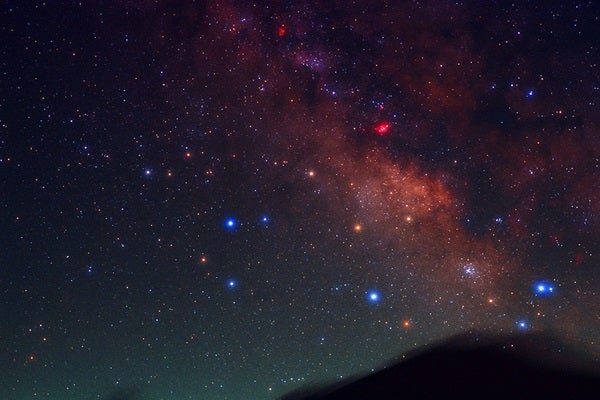Perhaps the most magnificent of all cosmic vistas is the one visible without any optical aid but sadly unavailable to urban (and many times suburban) dwellers — the Milky Way. Those fortunate enough to be in the countryside on a crisp, moonless late-summer evening can witness this glowing river of light arching north to south across the sky. It’s the same mystical glow that dazzled early humans and inspired numerous myths and legends.
One of my favorite late-summer activities is what I call a “Milky Way cruise.” On a clear, dark evening, I settle into a reclining lawn chair, and gaze upward. As my eyes dark-adapt, the Milky Way looms larger and brighter. I pull out my binoculars and begin a lazy sweep up and down its length, from Cassiopeia in the north to Sagittarius above the southern horizon. There’s nothing scientific about this cruise. I don’t measure anything, nor do I try to identify and sketch each cluster or nebula I encounter. I simply lie back and take in a cosmic vista equal in majesty to Earth’s Grand Canyon.
Galileo most likely spent many nights cruising the Milky Way. Unlike my excursions, his were every bit scientific. At the time, the makeup of the Milky Way was unknown — its nature the speculation of philosophers. Using his telescope, Galileo found the Milky Way to be “a congeries of innumerable stars grouped together in clusters. Upon whatever part of it the telescope is directed, a vast crowd of stars is immediately presented to view.” Without knowing it, Galileo had discovered our galaxy.
But what will the weather be like tonight? It’s a question all astronomers ask (except, of course, those who engage in radio astronomy), and one especially important if observing includes a trip to a dark-sky site. For those of us who ply the visible part of the electromagnetic spectrum and would like to enjoy a Milky Way vista, clouds or a turbulent atmosphere can spoil the sky show. Knowledge of current and impending weather patterns is indispensable for planning an evening observing session.
A great source of up-to-date weather information is the Internet. So, I’ve collected a list of three sites you might want to try:
The simplest of the trio, Intellicast.com provides a map of cloud cover for the United States, southern Canada, and northern Mexico from its “Sky Watch” page (located in the “National Outdoors” section). Predictions for the next 24 hours appear in 6-hour increments.
Rather than portraying weather conditions on a standard map, ClearDarkSky.com displays weather factors graphically in a series of hourly blocks, which are very popular with Astronomy.com Forum users. ClearDarkSky.com covers the same area as Intellicast.com. You can receive weather data specific to your locale for a period of nearly 48 hours. Besides cloud cover, ClearDarkSky.com delivers information on seeing and transparency, darkness, wind, humidity, and temperature.
The new kid on the block, SkippySky (skippysky.com.au) is the collaborative brainchild of Australians Andrew Cool and Dr. Robert Dahni. SkippySky is more global than the other two sites — it includes information for Europe, Australia, and New Zealand, parts of Africa and South America, as well as North America. Weather maps covering 3 days in 3-hour intervals include data on cloud cover, seeing and transparency, jet stream activity, risk of dewing, wind, temperature, and pressure.
Next time you want the lowdown on Milky Way observing weather (or any observing weather, for that matter), you’ll know of a few sites where you can look.
Questions, comments, or suggestions? E-mail me at gchaple@hotmail.com. Next month: a Galilean miss. Clear skies!
August 2009: Double the observing fun
See an archive of Glenn Chaple’s observing basics











